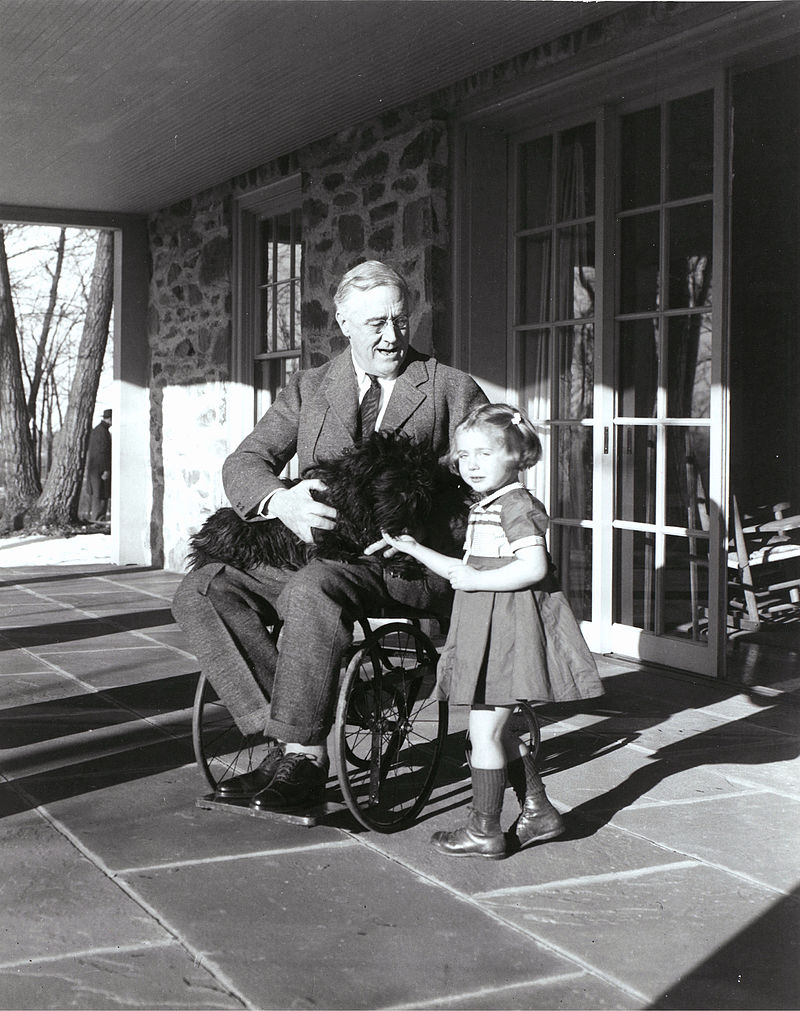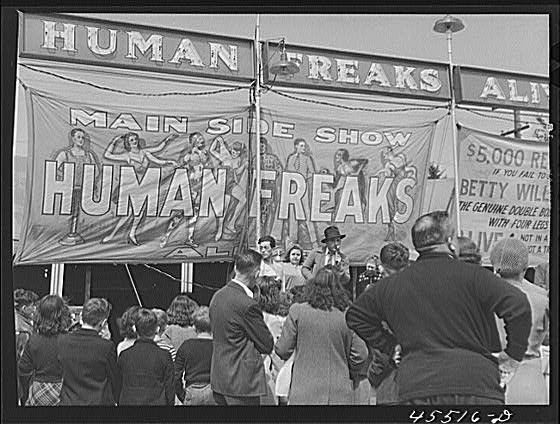Americans with disabilities compose approximately 50 million people today, and yet remains largely removed from the historical record. The road to recognition has been long and varied; from President Franklin Delano Roosevelt’s use of a wheelchair while in office, to the popularity of “freak shows,” wherein physical ailments were put on display. How have organizations and activist groups groups dealt with stigma and asked for rights to be able to participate in the public sphere in the United States?
First year history graduate student John Carranza, specializing in disability history, sheds some light on historical representations of disability, and how modern understanding of disability is informed by the past.
Guests
 John A. CarranzaDoctoral Candidate in History, The University of Texas at Austin
John A. CarranzaDoctoral Candidate in History, The University of Texas at Austin
Hosts
 Augusta Dell’OmoDoctoral Candidate, Department of History, The University of Texas at Austin
Augusta Dell’OmoDoctoral Candidate, Department of History, The University of Texas at Austin
So I think this podcast, for me is particularly timely, because as I am sure you know (but for our viewers) the Paralympic Games are currently taking place in Rio. This involves athletes with a range of disabilities including impaired muscle power, impaired range of motion, visual impairments and intellectual impairment. The Paralympics were originally started by a small group of British World War II Veterans in 1948, and is now it is one of the biggest sporting events of the 21st century. While this is true, there are also huge problems with recognition, respect, and funding for these events. This is largely indicative of the historical record of people with disabilities, whose history often never makes it into the public memory, and yet has been one of the most marginalized groups historically in society. So, John, why don’t you start off with telling us about what is disability history?
Disability history is actually an all-encompassing term, so it means a lot of different things. What we look at as historians of disability is pretty much physical and mental disabilities is usually how we characterize it. What we are looking specifically is the body, so the body becomes a site for how we can interpret disability. There is really a lot of aspects to disability history: it’s a story about independence but it is also a story about dependence. It is temporary in a lot of instances disability, sometimes people can move in and out of disability, while for a lot of other people, it’s permanent, and they usually require lifelong assistance of some sort. And it is also essentially a demand for rights, so it’s a movement, it has evolved into a movement, in which now people with disabilities are trying to get more rights within American society.
Framing in the context of American society, what are some key moments that you would point to as essential for understanding the history of disabled people in the United States?
In the United States, there are a ton. There is actually a really good survey history of disability history by Professor Kim Nielsen, and it is called A Disability History of the United States. She traces disability pretty much from the time of the Native Americans, up to now. But some of the ones that really define American society and disability would be Ellis Island, so when we get the large scale movement of immigrants coming into the United States. When a lot of these immigrants are coming in, we see that they have to undergo a series of tests, and they are short tests. These inspectors don’t take too much time actually inspecting them, but what they are looking for is any sort of hint of these immigrants possibly having some sort of illness or disability that would require them to use a lot of American resources. They were really trying to avoid that. We want individuals to come in that can be pretty independent and self-sufficient. In terms of Ellis Island again, they would check for homosexuality, so it is at this time that we see homosexuality as being a disability. They would be asked a series of questions like are you interested in the opposite sex, do you have friends of the opposite sex? So they are trying to screen for all of that.
Another good pivotal moment and monumental figure is Franklin Delano Roosevelt. He was one of our great American presidents who served several terms, and he was actually diagnosed with polio at the age of 39. So in 1921 he contracted polio and as a result of having polio that left him with a pretty severe disability, where he was not able to walk or stand for long periods of time. And so as a result, he needed a lot of assistance, and he wore leg braces to help him get around. But what is important about FDR, is we have this figure coming in around the time of the Great Depression, and he is going to act like a sort of savior figure. What is interesting is that FDR, even though he is disabled, he still stands as this huge monument to American history, and he is this great leader that leads us through the Depression. He helps pivot the New Deal through Congress, and he also sees us through part of World War II. At that time, his disability was pretty well known in American society, and a lot of Americans really accepted that, and so I think that it is kind of interesting to look at FDR and his tenure as president, and compare it to our politics today, where we see any sort of disability or illness within our presidential candidates as being disqualifying. He stands as this kind of one great figure.

Finally, I guess a third great moment was the Americans with Disabilities Act (ADA) of 1990. It was signed into law by George H.W. Bush. This is sort of a culmination of a lot of different efforts by people with disabilities trying to agitate for more rights, more inclusion, more accessibility in American society. Really what the ADA does is it gives us a lot of what we are familiar with today, so now we know that all buildings have to be accessible to people with disabilities. I don’t know if you’ve ever seen but there are telephones with braille and specialized telephones now where people with speech or hearing disabilities can now communicate. State and local governments also had to be readily accessible as well. So the ADA is the culmination of a disability rights movement that began pretty much around the time of FDR, when people were out of work and they started demanding work, because oftentimes they were precluded from the New Deal. So that way those jobs were given to “able bodied” individuals.
So when you are looking at the Americans with Disabilities Act or FDR’s tenure as president, how is research in this particular field usually done? Is it archival or is it oral histories?
Disability history is interesting because it’s everywhere, but then it is kind of nowhere, all at the same time. Two professors who have worked on disability history, Paul Longmore and Lauri Umansky have come with this idea that a lot of researchers might believe that there aren’t any sources. And really, Longmore and Umansky, as well as Kim Nielsen, they kind of delve into the archives and they are able to find a lot of these good examples of disability. The answer to your question is a lot of primary source documents, so maybe some of the more traditional documents. We would look at maybe diaries, letters, some medical records if they are old enough. I think nowadays, we are more concerned with people’s privacy, so we destroy a lot of medical records, but definitely those pictures, letters have also been used to construct disability history, to get what these people were maybe experiencing in the past.
So correct me if I’m wrong, but individuals with disabilities is actually considered the largest minority group in the United States, so when you’re talking about this rich primary source base for you all to work with, why is disability as a historical subject not been widely studied?
I think that also has a lot to do with a misconception that there are not sources. I think a lot of researchers are used to being able to go somewhere and find something very easily, find documents very easily. I think with disability history it requires just a little bit more digging into personal lives and backgrounds, to construct this history. I also think a lot of it is personal, so researchers tend to focus on what they are familiar with, what their personal likes are, maybe if they have personal attachments to a region or a group of people they focus on that. Possibly that might be one of the reasons why we don’t really study disability history as much as maybe some of the other regions or minority groups.
Can you talk about how people with disabilities have been traditionally represented? You mention these groundbreaking works that have really transformed our understanding of disability history, but what is the historical representation of people with disabilities?
It hasn’t been very good. People with disabilities have oftentimes been categorized by a variety of different terms and phrases, we see “idiocy” and “imbecile”, just a couple of examples used to describe people with mental disabilities. We also see “defectives” is also another good example. They are really not depicted very well, so in the 19th and the beginning of the 20th century, they are oftentimes viewed as tragic and pitiful, and usually a strain on society because oftentimes who is going to take care of these individuals who have these disabilities if their families can’t? Really they are pushed to the margins of society, so they are usually represented in that way. In the 1840s, people with disabilities end up joining freak shows and circuses, and these traveling vaudeville shows, so these people that are already living on the margins of society, and sometimes even further marginalized to a certain degree, because now they are living in these institutions where people can now go and view them as some sort of “other,” some sort of distant freak, essentially. That is what these freak shows were. And so for a lot of these, particularly P.T. Barnum had his own show where he had people with differing body types, people would join these and to some degree, they would become moderately successful. Even though they had disabilities, a lot of people were paying to go see them, so they made money off their disability so to speak.

It goes back to the point you made about independence versus dependence at the beginning and this structure in place.
Right, and we see a lot of that. There were actually conjoined twins, and they were from Southeast Asia. They were the “Bunker Twins,” they had been adopted, so they went and they worked with P.T. Barnum, and they were able to live some pretty successful lives. After they left the P.T. Barnum show, they ended up opening their own plantation, they married a couple of other sisters, and so they had pretty prosperous lives. In these freak shows, we still see them as these tragic figures because they have different bodies from us, but yet we pay to see them. They are still able to support themselves. It is pretty interesting because we see that sort of representation today, so if you watch American Horror Story, they had one particular part that was on the freak show. A lot of the freaks on American Horror Story, were actually pretty representative of the freaks of the past. It is just unfortunate that on the show they all meet tragic ends, so in this instance we don’t really have them becoming independent and becoming successful. Instead, it ends in tragedy, which is one way that disability is often characterized in American society.
Another way that people have been represented in the past has to do with people with intellectual disabilities, so what was formally known as mental retardation. Have you seen One Flew Over the Cuckoo’s Nest or read the book?
Yep.
So we know that asylum where they were staying was pretty oppressive because we had Nurse Ratched. We have this authority figure that runs this regimented schedule, and she keeps them all on track, so they are not able to make decisions for themselves until Randal Patrick McMurphy comes in. But when he comes in, he tries to upset the system, and in that instance, we start seeing these patients try and demand their own independence. However, this was another instance where we see it meets a tragic fate, where we have a suicide, and then McMurphy gets a lobotomy. These are the different sorts of representations, and there are several other ones as well. But for the most part, they often are tragic individuals that don’t really rise above their disability, per say.

Does this come into your motivations for studying disability history, in dealing with these false constructions and representations of disabled people? What other personal motivations do you have for studying this subject?
For me, it is pretty personal. I got my undergraduate degree at the University of the Incarnate Word and I got my masters at the University of Texas at San Antonio. During that time period while I was going to school and studying history, I actually worked in a group home with people with intellectual disabilities as well as other physical disabilities. What I saw was very interesting. I had been in the field for about ten years, and so in that time I was able to get to know a lot of these individuals. What you see is not how they are often characterized in regular society. What I saw were a lot of individuals who were pretty much like you and I. They had their hopes and dreams, many of them wanted to move out of their group home. There were some that had boyfriends or girlfriends and they wanted to get married just like you or I possibly could. They wanted to have jobs. They just wanted to be included, and they didn’t really for the most part, see themselves as being outside of society, although society tends to construct that around them. Personally, they became my friends: I had a lot of fun working with them. When I graduated with my masters, I didn’t really know what I was going to do. I had my humanities degree but I also had a lot of this other outside work. It wasn’t until I actually read A Disability History of the United States by Professor Kim Nielsen that I realized maybe I can take this route where I can combine my humanities as well as my own personal experiences and make it into a work of history and explore how people with disabilities have been portrayed, and have been included or not included in society over time.
How do you think our understanding of disability can be taken in a global context, in understanding societies in worldwide portrayal of disability?
I think disability in general is worldwide. All across the world, people have bodies, and peoples’ bodies tend to break down, or they are born with disabilities. I think it adds a lot of value to begin to learn in an increasingly globalizing society how other cultures treat individuals with disabilities. It is important to have that comparative aspect, especially in the United States, where we are proud to be an immigrant nation, where we bring people in. I think, for example, if we look at some place like Nigeria and the way they address children with disabilities, they often see that child having a disability for different reasons. That child has gotten a disability for a number of possible reasons, some of which might include a curse from God, which would have been a consequence of someone being disobedient, or breaking God’s commandments. It could have been a cause of witches or wizards, adultery or arguing and fighting with elders: there are a variety of different reasons. I think that it if we come back to the United States and we have a Nigerian family with a child with a disability, and they are still very connected to their home country, it is important to understand those different societal aspects so that we begin to formulate plans on how to help the child with the disability.
Another way that look at disability in the global context is, and we can actually refer to a very current global health situation, and that is the Zika virus. We know that it is spreading pretty rapidly. It has been determined that the Zika virus tends to cause fetal abnormalities such as microcephaly, which means a smaller head size. That in itself can lead to a variety of different complications such as seizures, developmental delay, not meeting all your developmental milestones. As a result of not tackling Zika, women possibly contracting the Zika virus and possibly having babies with microcephaly, this creates a problem because now with babies born with microcephaly it becomes an enormous public health concern, and it becomes very financially draining, not just on the parents, but also on our political system and any sort of programs that are there to help. Not to mention emotionally draining as well.
And it disproportionately effects low income families and non-white families, so that is a huge factor that plays into this cycle. Can you talk to us a little bit about some of the movements that are going on with disability rights right now? I know when I was an undergraduate student one of the big movements that one of our disability advocacy groups did was the use of the “r-word,” the use of the word “retarded” in everyday speech. Are there similar movements like that, are there ones focused on more policy based? From your experience what have you seen?
I think right now, the movement to remove the r-word is still very much a big part of the movement. It still hasn’t been completely eradicated, and going into that, it has been determined that the use of “retarded” to describe something negative, is falling by the wayside, much like other words in our society have. I think there is also a move to ensure that people with disabilities still have access to everything around them in the community, different resources, and rehabilitative therapies and medicine. A big part of the movement, I would say, is political, so we want to ensure that our lawmakers are providing enough funds and programs such as Medicaid that help to cover such therapies such as speech therapy, physical therapy, occupational therapy, as well as a variety of other necessities for people with disabilities.
Spread the word to end the word, slogan and campaign created by Special Olympics and Best Buddies International.
As a former teacher, you used to work with students, how would you like to see disability taught in the American public classroom?
It would be great to see people with disabilities included a little bit more. There has been a great move towards inclusion, so we include a lot of minorities in our curriculum. I think it would be great to begin to focus on people with disabilities, and really when you think about it, it tends to tie into a variety of the other minorities, so African-Americans with disabilities can be discriminated against, much like a member of the LGBTQ community can be discriminated against.
There is an intersectionality of a lot of these issues.
Yes, there is a lot of intersection, especially with women and a variety of different minorities. So, I think it would be great if we begin to work in disability in a manner, in which maybe it can align with some of the other minority groups, and even we can begin to focus on the actual disability movement that began in the 50s and 60s. But a lot of it is political. We tend to hear arguments about political correctness, and I think if we are looking at a public school textbook, maybe there is a lot more work to be done in terms of education and inclusion. In terms of the college American history courses, I would say, again building on this literature and trying to bring recognition to disability history, and maybe we can teach more of that alongside the textbook or within the textbook, instead of talking about Americans with Disabilities Act and leaving it at that.